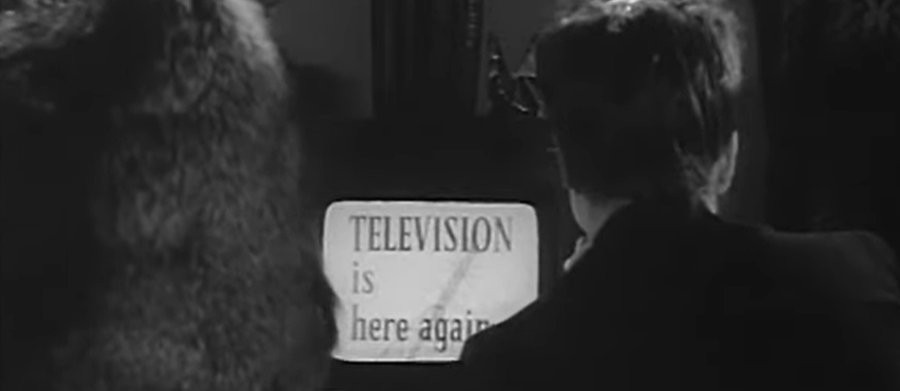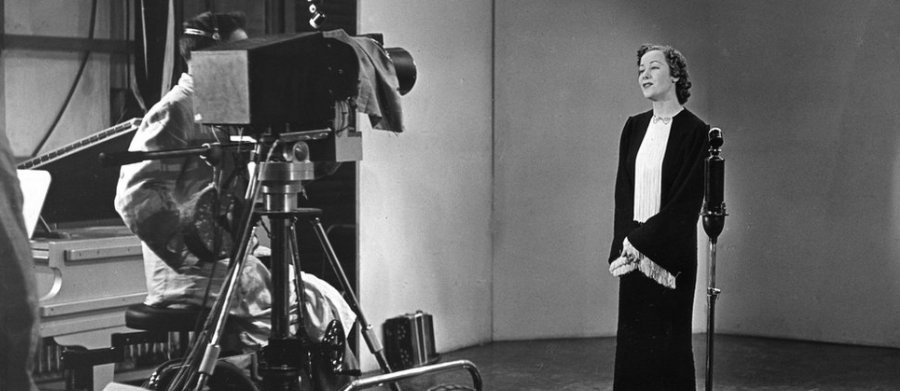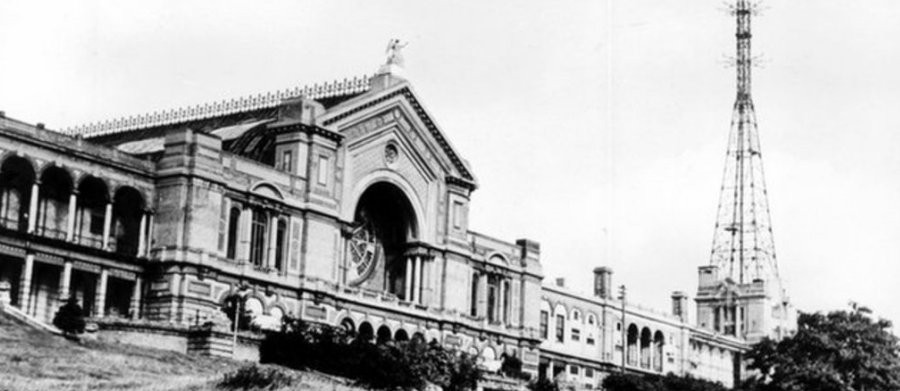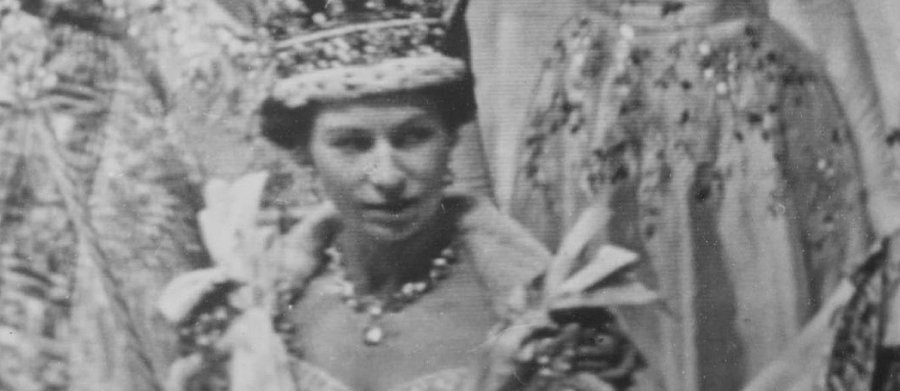
History of the BBC: The Coronation (1953)
It was on 2 June 1953 for the Coronation of Elizabeth 11 that television really came into its own. Permission had never been given for television cameras in Westminster Abbey before, as many felt it wrong for people to watch such a solemn occasion whilst drinking tea or chatting to family members in their front rooms. However, when it was announced that this historic occasion was indeed to be televised, the weeks leading up to the Coronation saw the sales of televisions rocket. The cost of the BBC's television operation on Coronation Day itself was £44,000, but in the weeks either side of it extra money was spent to mark and reflect the celebrations. The BBC made three documentary films; 'When the Queen is Crowned' - dealing with the Coronation preparations; 'The Second Elizabeth', a picture biography, and 'What is the Crown', an explanation of the Abbey ceremony. A specially commissioned play, 'All on a Summer's Day', was shown, about a Cockney family heading off for the Coronation ceremony as well as light-hearted entertainment shows featuring Ted Ray, Terry-Thomas, Arthur Askey, Michael Bentine and Jon Pertwee. The pageantry of the Royal Tournament at Earl's Court was covered as was Trooping the Colour; attended by unprecedented crowds of visitors to London.
In the run-up to the Coronation Day coverage the BBC were able to 'dry-run' the main event with what was described as a "minor Coronation Day operation", using ten cameras to cover the Queen's visit to Edinburgh. The day itself was a day of firsts. For the first time a television news crew was flown from London to Canada where it was able to transmit the first televised Coronation ceremony a few hours after it had taken place. In Britain, on 2 June, the streets were deserted as stores and businesses closed to allow staff to go home and watch the ceremony on television. If television had been regarded up to now as nothing more than a gimmick or the luxury of a select few, then that perception was blown away on this historic day.
Here; reproduced from The Television Annual for 1954, is journalist Kenneth Baily's account of the day that set the course for the future of British television.
At The Crowning of Elizabeth II Television Welded the Nation as Never Before
In most parts of the country, in the towns and cities, streets were deserted on the morning of Coronation Day, 2 June, 1953. In the residential quarters, and in the suburbs, groups of cars were parked, here and there, in the silent roads. They stood outside houses where the H aerial of TV had drawn neighbours and friends inside-to take part in what became, as hour passed hour, the greatest day in television's short and remarkable history. That day the TV audience, for the first time, was doubling the sound-radio audience. Of the adult population in Britain, numbering about 36,500,000, fifty-six per cent watched the Coronation on TV-20,400,000 viewers. Sound radio had 11,700,000 listeners. In the longest-established TV areas the TV audience exceeded the listening one to an even greater extent; in London and the Midlands there were three times as many viewers as listeners. More than half the viewers all over the country watched in the homes of friends. About half a million watched big-screen relays in cinemas and other public places.
As befits the coming generation, two hundred children saw the Coronation procession by the TV of the future - in colour. They were at the Great Ormond Street Hospital in London. By closed-circuit they received pictures from three TV colour cameras overlooking Parliament Square. The first real throb of Coronation excitement came to viewers on the eve of Coronation Day. Cameras stationed at the Victoria Memorial, at the head of the Mall, opposite Buckingham Palace, showed the unbroken line of pavement squatters preparing to spend the night in the open. Barrie Edgar interviewed some of them - including an Australian family which had sailed all the way in a ketch to see the Coronation, and a Swiss Alpine guide.
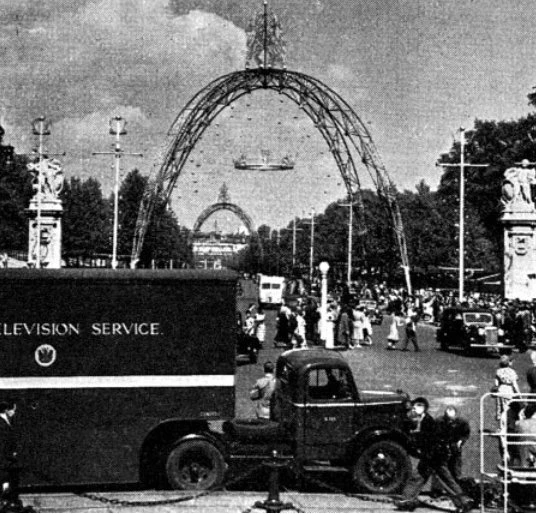
On Coronation Day morning, Sylvia Peters, looking happy and elegantly though quietly gowned, opened the historic transmission. Three cameras at the Victoria Memorial then showed the procession leaving the Palace. Surprisingly quickly came the viewers' first view of Queen Elizabeth on her Coronation Day. In close-up, the gold-encrusted window of her coach was held in a long pan of what seemed to amount to thrilling minutes, as she smiled beautifully and happily on her people. Wisely, commentators Berkeley Smith and Chester Wilmot let this exciting picture tell its own story. No words of theirs could have aided either the privileged intimacy or the beauty of that TV moment. On the Victoria Embankment, Max Robertson, beside three more cameras, found himself shouting against the full-throated cheering of thirty-thousand school children, as the Queen passed on her way. Then, high on the massive covered stands opposite the specially built Annexe to Westminster Abbey, two cameras picked up the unfolding story at its first crescendo-as the Queen's procession arrived at the historic place of Coronation. Here Michael Henderson and Mary Hill assisted the rapid flow of exciting pictures by which viewers saw royalty, statesmen and dignitaries arrive at the Abbey. A third camera, perched precariously on the slated roof of an eight-storey building, helped; while yet another, inside the Annexe door, gave glimpses of the Queen Mother and Princess Margaret stepping from their coach.
Now it was the turn of TV's men inside the Abbey. In a cubicle perched high in the Triforium, directly overlooking the Coronation Theatre, Richard Dimbleby took up the great story. Beside him was one of four cameras placed discreetly inside the Abbey, occupying such a small space that their attendant cameramen had been chosen for their slightness of build.
A camera over the West Door surveyed the Nave as the procession of royal and ecclesiastical splendour moved towards the place of the historic ceremony. Two more cameras watched the Theatre from the organ screen and South Transept. In a special TV control-room, raised adjacent to the Abbey's outer wall, Peter Dimmock took up the task he performed with such faultless sensitivity-the mixing of these cameras' pictures into a rhythmic pattern of sympathetic interpretation.
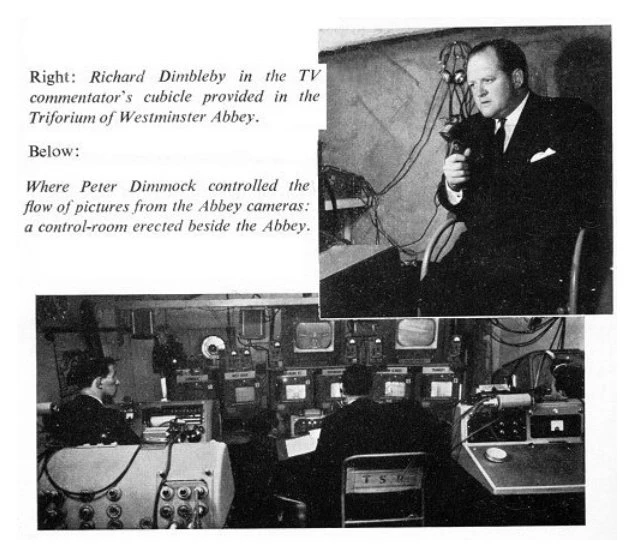
Of that Coronation ceremony every viewer must hold his (sic) own special memories. The screen's framing of Queen Elizabeth, full length, to the cry of "Vigat Regina!" The shot of shoulders and heads as she seplied "I am willing" to the Archbishop's query: "Madam, is Your Majesty willing to take the Oath?" The tactful watch of the cameras as she turned the pages in her copy of the order of service. The screen filled again with the slight and solemn figure as she was divested of bejewelled ornament. The glimpse of little page-boys carrying in coronets as the moment of crowning neared. The camera's capture of the Queen Mother tenderly bending over the peeping, curious child, Prince Charles. The duke of Edinburgh's proud and serious mien as he approached to do homage to his wife, that day so much a Queen.
These incidents were etched, one by one, on a nation's mind. As TV so fittingly found the way to do its rightful duty to religion, tradition, Queen and people, it brought a new experience of national unity to life. And as the great procession moved back to Buckingham Palace, past three more cameras in Hyde Park, still came revealing glimpses of human idiosyncrasy within ordered pageantry. The newly crowned Queen's simple white handbag on the seat before her within the golden coach. The joyous defiance of pelting rain by Salote, Queen of Tonga, in her open carriage. The long-held wheeling close up, again, as the queen smiled from the coach window on entering the Palace. The inquisitive outreach of young Prince Charles's hand to the golden Armill, still about the Queen's wrist, as they stood on the balcony.
And later still, by a stroke of most fitting genius, TV took viewers back to the Abbey, to look down on the emptied Coronation Theatre, quiet in such tremendous memories-an epilogue sublime, touching and human as had been the great day itself.

The significance of televising the Coronation of Elizabeth II will be scored in the history of TV, as it is written coolly and objectively in the years to come. The Archbishop of Canterbury himself admitted that the televising of the Abbey ceremony had assured him at last of TV's appropriateness at times of religious observance. A million people at least saw the Coronation in France, Belgium, the Netherlands and Western Germany. In the United States viewers watched telefilms, flown first by the helicopter from Alexandra Palace to London Airport, thence in relays of Canberra jet-bombers.
In the two months preceding the Coronation more TV sets were bought than in any other two months. At least two and a half million sets were in use-giving TV in 1953 a family audience of about eight million people. To say that the Coronation put TV on the map is trite. On 2 June, 1953, TV unleashed a binding power through the nation, the significance of which to a national life, at times of joy or of strife, is going to be immense and historically important.
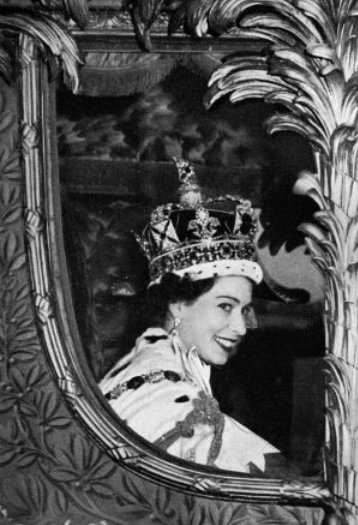
Indeed, it now came to the attention of many people within the expanding TV industry that with more sales of TV sets there would be more demand for longer broadcasting hours, and more variety of programmes. Many felt that the BBC would not be able to cope. A government White Paper on Broadcasting had already acknowledged (in 1952) the need for a wider choice and ultimately some competition for the BBC. An organisation called the National Television Council had formed to resist plans for commercial television as another committee, the Radio and Television Group, made up of a number of Conservative MP's were now pushing for a Television Bill that would give Royal Assent to a second TV channel.
Related Articles (Previous Chapters): The First Television Era - Ally Pally's Secret War - Back After the War
This article was first published on Television Heaven's companion site Teletronic. A much fuller account of the BBC's early days as well as a comprehensive history of television can be found here.
Published on January 16th, 2020. Written by Laurence Marcus - Sources of reference: (Main body not in bold) The Television Annual for 1954 for Television Heaven.


